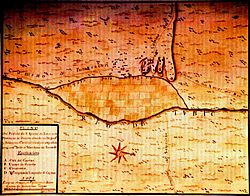Tubac, Arizona facts for kids
Quick facts for kids
Tubac, Arizona
|
|
|---|---|

St. Ann's Church, Tubac, 1937
|
|

Location in Santa Cruz County and the state of Arizona
|
|

18th century map of Tubac and surroundings
|
|
| Country | United States |
| State | Arizona |
| County | Santa Cruz |
| Area | |
| • Total | 10.85 sq mi (28.10 km2) |
| • Land | 10.85 sq mi (28.09 km2) |
| • Water | 0.00 sq mi (0.01 km2) |
| Elevation | 3,209 ft (978 m) |
| Population
(2020)
|
|
| • Total | 1,581 |
| • Density | 145.75/sq mi (56.28/km2) |
| Time zone | UTC-7 (MST (no DST)) |
| ZIP codes |
85640, 85646
|
| Area code(s) | 520 |
| FIPS code | 04-75940 |
| GNIS feature ID | 0035489 |
Tubac is a small community in Santa Cruz County, Arizona, United States. It is a "census-designated place" (CDP), which means it's a community that is not officially a city or town but is recognized for census purposes.
In 2020, about 1,581 people lived there. The name "Tubac" comes from the O'odham word Cuwak, meaning "place of dark water." It was first spelled Tubaca by the Spanish, but the last "a" was later dropped. Tubac is located along the Santa Cruz River.
Tubac was the very first Spanish fort in what is now Arizona. It was left empty for a while after a local uprising in the 1700s. Later, in the 1800s, miners, farmers, and ranchers moved back. Today, Tubac is famous as a place where many artists live and work.
Contents
History of Tubac
Early Spanish Settlement
Tubac was founded in 1752 as a Spanish fort, called a presidio. It was the first Spanish military base in what is now Arizona. Tubac was an important stop on the Camino Real, also known as the "Royal Road." This road connected Mexico to Spanish settlements in California.
One of Tubac's most famous Spanish residents was Juan Bautista de Anza. He was stationed there from 1760 to 1776. During his time, de Anza built a chapel called Santa Gertrudis. The remains of this chapel are now under the current St. Ann's Church.
Conflicts and Abandonment
In the 1840s, Apache groups often attacked Tubac. This forced the Mexican people from Sonora to leave both Tumacacori and Tubac.
Tubac was also the site of a four-day siege in 1861. This battle involved the people of Tubac, soldiers from the Confederate army, and Apache warriors. The Confederates won the siege. They raised the Confederate flag that was used by their headquarters. However, when Union troops started to get close to Tucson, the Confederate soldiers left Tubac. The town became empty again, with grass growing in the streets and adobe houses falling apart.
Tubac as an Art Colony
From the 1930s to the 1960s, Tubac began to change into an art colony. In 1948, painter Dale Nichols opened an art school there. He also helped fix up some of Tubac's old buildings. Some of his students included watercolor artist Al Romo and sculptor Bob Brisley.
In 1955, artist Ross Stefan opened his own art studio in Tubac. In 1961, the Santa Cruz Valley Art Association was created with 80 members. This group started the Tubac Festival of the Arts in 1964. Other important artists who lived in Tubac included Sophie and Harwood Steiger, Hal Empie, and Hugh Cabot.
Geography and Location
Tubac is located at 31°37′32″N 111°3′7″W / 31.62556°N 111.05194°W.
The community covers a total area of about 28.0 square kilometers (about 10.8 square miles). All of this area is land.
Population and People
| Historical population | |||
|---|---|---|---|
| Census | Pop. | %± | |
| 2020 | 1,581 | — | |
| U.S. Decennial Census | |||
Population Details
According to the 2010 census, there were 1,191 people living in Tubac. Most of the people (76.7%) were non-Hispanic White. About 20.7% of the population were Hispanic or Latino.
In Tubac, 1.5% of the people were aged 0–4 years old. About 4.7% were between 5 and 17 years old. The largest group, 51.0%, was between 18 and 64 years old. A large number of people, 42.5%, were 65 years old or older. The population of Tubac is slightly more female (52.4%) than male (47.6%).
Arts and Culture in Tubac
The remains of the old Spanish fort are now part of the Tubac Presidio State Historic Park. This park has a museum about the area's history. It also features an underground display of old archaeological finds and other historic buildings.
Today, Tubac is home to more than 100 art galleries. You can find shops selling home decor, gifts, and jewelry. Many potters and artists of all kinds have studios there. There is also an active art school. Tubac has several restaurants and a golf resort located in a green valley. This valley has some of the oldest cottonwood trees in Arizona.
Historic buildings and ruins in Tubac include the Presidio Captains Quarters, St. Ann's Catholic Church, the Tubac schoolhouse, and various old homes.
Notable People from Tubac
Will Rogers, Jr., who was a Congressman, retired to a ranch near Tubac. He is buried in the Tubac Cemetery.
See also
 In Spanish: Tubac para niños
In Spanish: Tubac para niños



